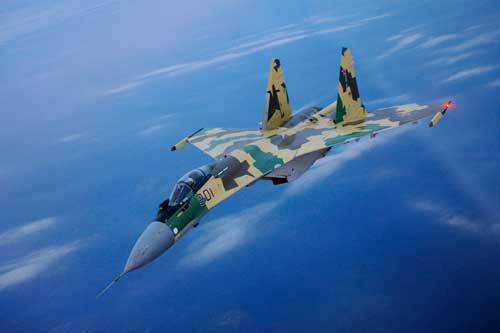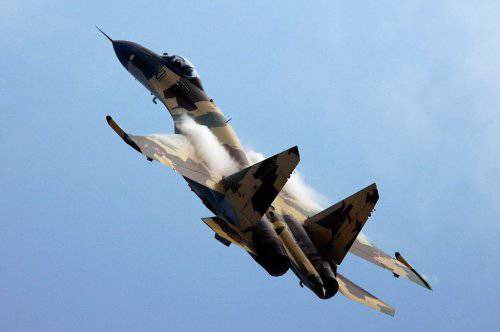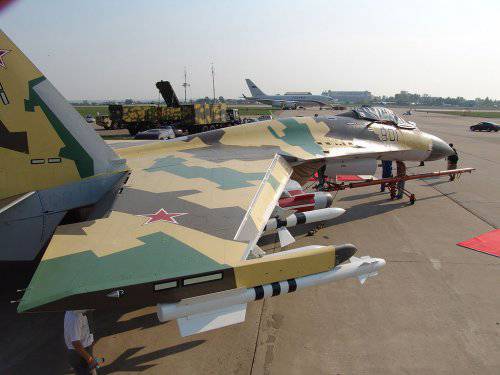Update soon

The promising Su-35С fighter - a deep modernization of the time-tested Su-27 - entered the final stage of preliminary factory tests. In the fall of this year, the Sukhoi Company intends to submit the aircraft for state joint tests, during which Russian military pilots will check it. According to Igor Demin, the chief designer of the Sukhoi Design Bureau, six Su-35С will participate in trials for combat use. In the plans - new fighters of the Russian Air Force to use along with the PAK FA created today.
Currently, two Su-35С fighters are participating in flight tests, but during the state tests their number will increase to six units. The third plane will fly into the air until the end of the 2010 year. According to Demin, the flight test program of the fighter provides for a large number of flights - this is due to the use of many new systems, units and weapons in the Su-35C, which require careful testing.
In July, the Sukhoi design bureau 2010 announced that during the preliminary tests, the new fighter fully confirmed the calculated characteristics. In particular, he managed to reach the ground speed of 1,4 thousands of km / h, and at an altitude of 2,5 thousands of km / h. The maximum altitude of the Su-35С - 19 thousand meters. Thanks to the H035 Irbis radar with a passive phased antenna array (PFAR), the target detection range in air-to-air mode was about 400 kilometers.
In the course of state tests for combat use, which will be conducted by military pilots, it is planned to test the performance of fighter weapons, onboard systems, as well as the characteristics already confirmed during preliminary tests. After all the checks are completed, the plane will begin to enter the Russian Air Force. This is expected to happen in the 2012 year. Formally, the Russian Air Force will receive the first Su-35С by the end of 2010 — it will be handed over to the military as part of the contract concluded in August 2009 of the year.
In the 2009 year, during the international MAKS air show in Zhukovsky near Moscow, the Ministry of Defense of the Russian Federation bought Su-48 Su-35C fighters from Sukhoi. This contract has become the largest in recent decades, the transaction for the purchase of combat aircraft for the Air Force of the country. The price of cars is unknown. Presumably the cost of one Su-35 is about 40 million dollars. Thus, the acquisition for the Air Force could cost the Defense Ministry almost 2 billion dollars, but the amount of the deal may have turned out to be lower.
Under the terms of the agreement, the Air Force will receive the ordered aircraft from 2010 to 2015 a year. As expected, a similar contract will be concluded for 2015-2020 years, that is, Russian troops will acquire about 96 Su-35C.
Serial production of these machines will be carried out at the Komsomolsk-on-Amur Aviation Production Association (KnAAPO). Now the company is engaged in the production of parts and components for future fighters. The start of series production is scheduled for the third to fourth quarters of 2010. Sukhoi also entered into contracts with third-party enterprises for the supply of components, mechanisms and equipment for aircraft.
In addition to the supply of Russian Air Force fighters, Sukhoi is negotiating the sale of aircraft to foreign buyers. Serial deliveries of the Su-35 export version should begin simultaneously with the Russian ones - in the 2012 year. Libya announced its intention to acquire 12-15 new fighters.
LONG WAY
Su-35 is created on the basis of Su-27 as a further development of this aircraft. The fighter with the same designation made the first flight in 1988 year. By the beginning of the 2000-s, 12 of Su-35 flight copies were produced, but later the program was turned in favor of the promising Su-37 project, another version of the Su-27 modernization. Later this project was also closed. In 2005, the decision was made to resume the development of the Su-35, which received the factory code Su-35BM (Basic Model).
Despite the long history the creation, the beginning of the development of the Su-35BM (the Russian Air Force will receive the Su-35С - Series) should still be considered the 2005, since the project of the promising fighter was significantly changed from the original program. Thus, the Su-35BM differs from the original Su-35 by the absence of front horizontal tail, it possesses a modern information and control system, a PFAR radar and engines that meet the requirements for the power plant of the fifth generation aircraft.
At Su-35BM are power plants "Product 117С", developed by NPO Saturn. This is a simplified version of the engines "Product 117", which will be installed on a promising fifth-generation aircraft PAK FA (T-50), created by "Dry". These engines are capable of providing supersonic flight speed without the use of afterburner, have a plasma ignition system and an all-directional thrust controlled vector. From "117 Product" version "C" differs only in the use of the old electronic-mechanical control system. In the future, it is planned to install the “35 Product” on the Su-117C.
In addition to the 035 "Irbis", which is considered the most powerful fighter radar in the world, it is planned to use additional L-band radar stations in the Su-35С, which will be located in the toes of the wings and keels. Such an arrangement of radars will increase the probability of detecting enemy stealth fighters, for example, the F-22 Raptor, due to the different angles of radiation of radio waves and their range. The Russian fighter will also receive an optical-electronic radar station. Su-35 will be able to accompany up to 30 and attack up to eight air targets or up to four and two ground targets, respectively.
The significantly modified Su-35С glider is made of composite and covered with radio absorbing materials. In combination with the electrically conductive coating of the cockpit canopy, as well as a decrease in the number of sensors on the fuselage, the fighter's visibility is significantly reduced compared with other fourth-generation aircraft. According to some estimates, in the frontal projection, the effective scattering area of the Su-35С is less than a square meter. For most modern fighters of the fourth generation, this figure averages 3-12 square meters.
Other innovations used in the Su-35С include modern electronic warfare systems that can also provide group electronic protection for airplanes while flying in a link. The cockpit will be equipped with two LCD multi-function displays with the ability to work in multi-screen mode, as well as a completely standard holographic indicator on the windshield. Resource Su-35С will make 6 thousand flight hours, service life - 30 years of operation, and resource of engines - 4 thousand flight hours.
The Su-35S will be able to reach speeds of up to 2,6 thousand km / h, and the practical range of the fighter will be about 3,6 thousand kilometers. The aircraft will be armed with a 30mm cannon with 150 rounds of ammunition, and will also receive 12 suspension points for a wide range of weapons: from air-to-air and air-to-surface missiles to unguided rockets, free-fall and corrected aviation bombs. In total, the Su-35S will be able to take on board a combat load weighing up to 8 tons.
The state armaments program currently being worked out for 2011-2020, which the government will consider on 30 in September of 2010, is expected to be financed in excess of 13 trillion rubles. A part of these funds will be spent on the re-equipment of the Russian Air Force, but whether it is limited to acquiring 96 Su-35С or the volume of purchases of these aircraft will be increased is still unknown. By some estimates, the Russian Air Force needs a 150-200 Su-35C. Fifth-generation T-50 fighters The Ministry of Defense so far intends to buy only 60 units.


Information